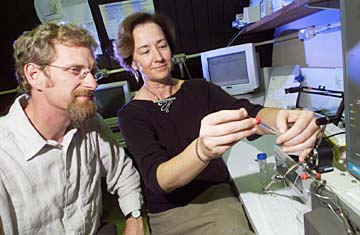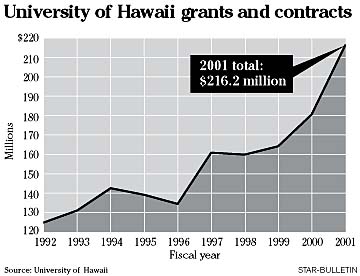


|
UH’s outside grants Grants to the University of Hawaii for research, training, instruments and other purposes rose nearly 20 percent in fiscal 2001, pumping $216.2 million into the island economy, compared with $180.6 million in the previous year.
up 20% and climbing
The funding pumps $216.2 million
into Hawaii's economy
in the 2001 fiscal yearHawaii squid could be key to
fathoming human infectionBy Helen Altonn
haltonn@starbulletin.comIf the trend continues, outside funding to UH will reach $270 million this fiscal year ending June 30, about 25 percent higher than last year, said Edward Laws, interim vice chancellor for research and graduate studies.

"Last year was a bumper year," said Frank O. Perkins, assistant vice president for research and graduate education, commending the faculty for the growth in grants."Their expertise and vigor in competing for and going after these grants and contracts has to be the answer to it," he said. "It's quite remarkable when you look at the duties placed on a faculty member with teaching, research, publications, and competing for grants and contracts for research. It's a substantial investment in time."
The School of Ocean & Earth Science & Technology was the big leader in total grants, followed by the John A. Burns School of Medicine, College of Natural Sciences, Cancer Research Center and the College of Tropical Agriculture & Human Resources.
The number of awards increased only 1.9 percent in the last fiscal year, but the amount of money was 19.7 percent greater, according to the UH Office of Research Services.
Moreover, research and nonresearch awards continue to climb, totaling $245 million in the 12-month period from Feb. 1, 2001, to Jan. 31, Laws noted.
The total from July 1, 2001, to Jan. 15 was $147.7 million, or 24 percent more than the amount for that period in 2000-01.
The volume of grants in extremely competitive areas is impressive, particularly since the money brought in has a multiplying effect on the state economy, Perkins said.
"The research enterprise at the University of Hawaii is something people of the state of Hawaii should take great pride in terms of international ranking, quality of scientists and productivity for the good of science and society that results from the support from the state," he said.
Federal and private, or extramural, funding for UH programs has nearly doubled in 10 years, from $124.9 million in 1991-92, and the annual figures reflect only new money.
UH-Manoa ranked 53rd among U.S. colleges and universities in terms of federal research and development expenditures in the March 2001 issue of the Chronicle of Higher Education.
The Center at the University of Florida, in a report last July on "The Top American Research Universities," ranked UH-Manoa as 37th among public research universities in terms of total research expenditures, based on 1999 data, and 31st in federal research expenditures.
Research unit leaders echoed Perkins' accolades to the faculty for the surge in research and nonresearch support.
"Citizens in Hawaii should realize that when we get these research dollars ... we are having a big impact economically on what happens in the state," said Charles Hayes, dean of the College of Natural Sciences. He said faculty members have excelled in botany and physics in that college.
C. Barry Raleigh, dean of the SOEST, noted that the school's faculty increased its research grants by about $12 million in the last fiscal year.
State investments in UH infrastructure and numbers of faculty in previous years have paid off, he said.
He cautioned, however, that "it's going to be difficult to continue to grow the research grant volume without yet another round of investment in the infrastructure and faculty."
Dr. Carl-Wilhelm Vogel, Cancer Research Center director, also said, "Given our size of faculty and our space limitation, our growth cannot continue without more space."
He said the standard increase in the center's grants in recent years has been about 25 percent, with the faculty contributing both to economic development and the community in terms of programs.
What distinguishes his research unit, he said, is that it receives only about $2 million in state general funds and is generating nearly 15 percent of all research funding by bringing in almost $20 million annually in outside money.
The center must pay for electricity, gardening, maintenance, security and other services that other research entities get in their budgets, he said. "In terms of leveraging money from programmatic support, it's almost $1 to $15," he said.
Top University of Hawaii recipients of research and nonresearch grants and awards in 2000-01: Schools of Ocean Science, Medicine top list of grants
>> School of Ocean & Earth Science & Technology, $50.1 million.
>> John A. Burns School of Medicine, $27.3 million.
>> College of Natural Sciences, $22.9 million.
>> Cancer Research Center of Hawaii, $19.7 million.
>> College of Tropical Agriculture & Human Resources, $13 million.
Leaders in research grants:
>> School of Ocean & Earth Science & Technology, $39.1 million.
>> College of Natural Sciences, $22.1 million.
>> Cancer Research Center, $19.1 million.
>> Institute for Astronomy, $11.4 million.
>> College of Tropical Agriculture & Human Resources, $10.6 million.
Major recipients of nonresearch awards, including training, instrumentation and special programs:
>> School of Medicine, $17.3 million.
>> College of Education (including the Center on Disability Studies), $12 million.
>> Community Colleges, $11.7 million.
>> School of Ocean & Earth Science & Technology, $10.9 million.
>> College of Business Administration, $3.7 million.
BACK TO TOP
|

|
A Hawaiian squid may help researchers understand chronic infections in humans. Hawaii squid could be key
to fathoming human infectionBy Helen Altonn
haltonn@starbulletin.comScientists at the University of Hawaii and University of Iowa have received a $2 million W.M. Keck Foundation grant to study the bobtail squid and chronic lung infection.
Both are examples of a persistent infection of an animal host by a bacterium, the researchers say.
UH scientists are specialists on the squid and its light-emitting bacterium, Vibrio fischeri. UI scientists are experts on lung infections in cystic fibrosis resulting from the bacterium Pseudomonas aeruginosa.
"What we're trying to figure out is what is the difference between the bacterium that lives with an animal and provides health and one that causes sickness," said Margaret McFall-Ngai, UH professor of biology.
She and Edward G. Ruby, professor of bacteriology, are working on the project at the Pacific Biomedical Research Center's Kewalo Laboratory.
They have been studying the squid since 1989 when they were University of Southern California faculty members. They joined UH in 1996.
UH President Evan Dobelle and UI President Mary Sue Coleman were involved in developing the Keck grant request, which Dobelle said will advance UH's goal to expand biomedical research.
Humans and other mammals have huge numbers of bacteria associated with them, some causing diseases and some essential for good health, McFall-Ngai said. One way biologists investigate such complex systems is with simple biology, she said.
"What we have in the Hawaiian squid is a simple system in which we have one host, or animal, and one bacterium, the light-emitting Vibrio fischeri, that lives on the squid's cell surfaces," she said.
Ruby and McFall-Ngai have been developing a system using squid to look at how benign bacteria interact with animals.
The biochemical, molecular and morphological changes seen in the squid in response to interaction with the bacterium are similar to those seen with the bacterial pathogen that attacks lungs of children with cystic fibrosis, she said.
The Iowa group, led by E. Peter Greenberg, professor of molecular pathogenesis and microbiology, is concentrating on the bacterium-related disease process in cystic fibrosis.
"They're studying disease; we're studying health," McFall-Ngai said.
The researchers have had long associations. Greenberg and Ruby have worked together since they were postdoctoral researchers at Harvard University.
Michael A. Apicella, UI head of microbiology, collaborates with McFall-Ngai on a National Institutes of Health study looking at how certain bacterial molecules trigger inflammation in humans.
Ruby said the researchers were drawn together by questions about persistent long-term colonizations of animal tissue by bacteria.
"We generally think of that as a negative thing because we're so focused on pathogenesis and disease," he said. But people generally are colonized by large numbers of important and beneficial bacteria, he said. "Their presence is as important as the absence of bad bacteria."
Few studies have been done on how beneficial bacteria colonize animals, yet UH and UI scientists have discovered "a lot of similarities in the way bacteria colonize us to our benefit, as well as to our detriment," Ruby said.
"The same kind of mechanisms are being used by bacteria to identify host tissue and begin to live in it," he said. The disease-causing bacterium is like a spy who fools the other side into thinking he's a good guy, which opens some tissues to it, then becomes a mole in the structure, Ruby said.
"They get the same kind of access we give beneficial bacteria, and once they gain entry, they try not to play the game fairly," he said.
"Because we have those doors there ... we're interested in finding the keys, because if you know the keys, you know how to design the locks better."
University of Hawaii Hawaii Institute for Marine Biology